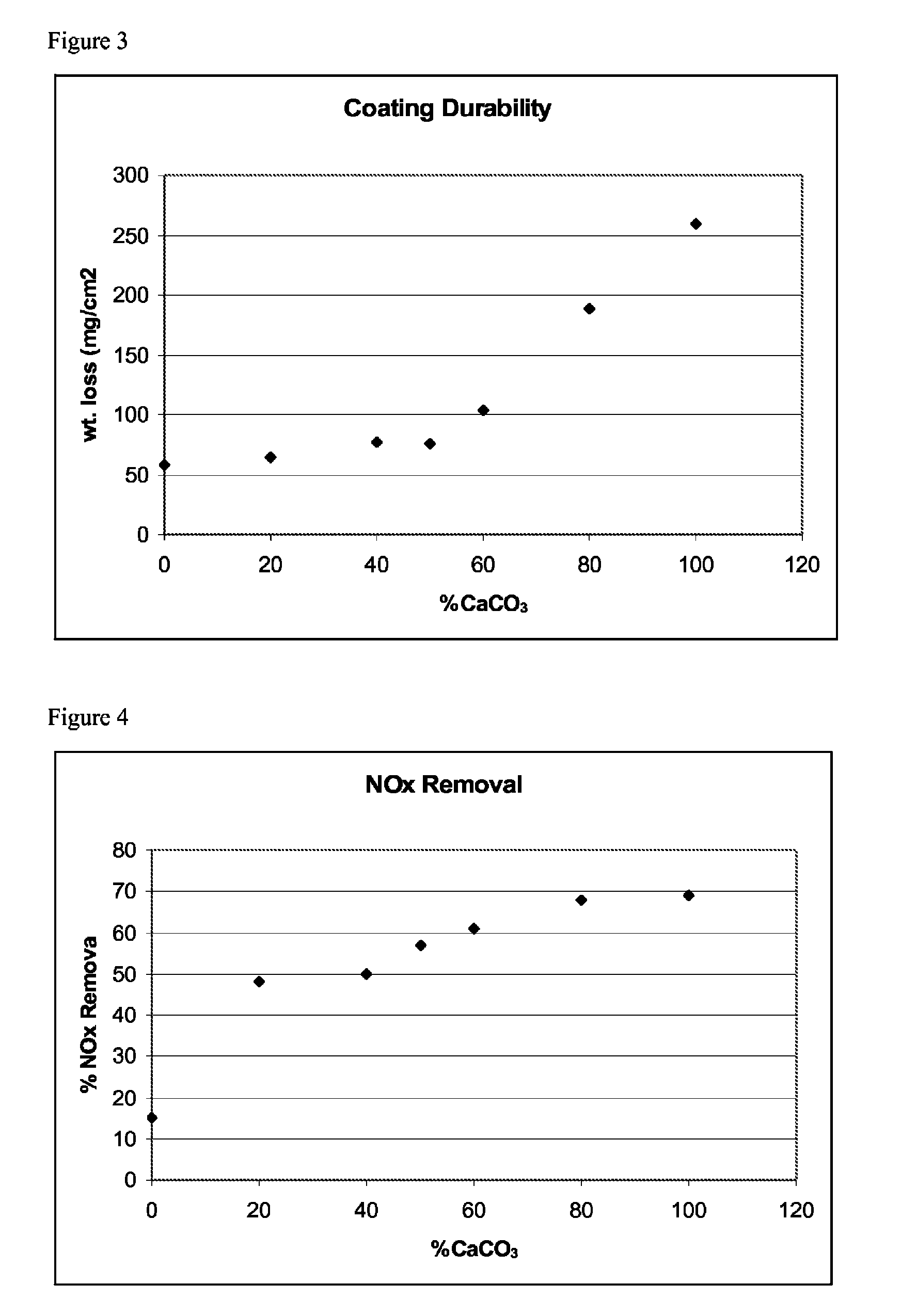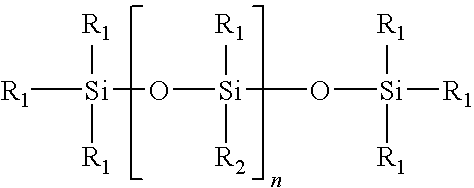Photocatalytic coating compositions
a technology of compositions and coatings, applied in the direction of coatings, pigment pastes, pigmenting treatment, etc., can solve the problems of exacerbated problems, degradation of coatings, and unsuitable photoactive properties, and achieve the effect of improving durability and opacity, and reducing cos
- Summary
- Abstract
- Description
- Claims
- Application Information
AI Technical Summary
Benefits of technology
Problems solved by technology
Method used
Image
Examples
example 1
[0073]The effect of lowering the concentration of polysiloxane polymer in the binder of the compositions on the durability of the coatings was examined by preparing six compositions with varying amounts of polysiloxane polymer mixed with styrene-acrylic copolymer. The complete compositions are presented in Table 1 below. The composition component quantities in table 1 are in weight (grams).
[0074]
TABLE 1Composition No.IngredientFunction123456Part ANatrosol ™thickener77.177.177.177.177.177.1250MRDispex ® N40dispersant2.22.22.22.22.22.2Nopco NXZantifoam0.30.30.30.30.30.3PC105TiO220.920.920.920.920.920.9photocatalystTiona ™-595TiO2 41.741.741.741.741.741.7pigmentCaCO3extender51.651.651.651.651.651.6Watersolvent18.218.218.218.218.218.2Part BWatersolvent17.214.712.311.09.87.3Silres ® BS45siloxane75.060.045.030.015.00polymerAcronal ™styrene015.030.045.060.075.0290DacrylicpolymerTexanol ™coalescent3.83.83.83.83.83.8BactericideBactericide0.30.30.30.30.30.3Total308.2303.3298.4295.9293.4288.4
[...
example 2
[0082]As discussed previously, it has been surprisingly found that replacement of a portion of the calcium carbonate extender with one or more alternate extenders improves the durability of the coatings. The ability of the inventive coatings to remove NOx pollutants, their durability and the effect of replacing part of the calcium carbonate with Opacilite™ on opacity was investigated by preparing seven water-based photocatalytic coatings comprising a standard 60:40 mixture (by volume) of a polysiloxane polymer (Silres® BS45) and a styrene-acrylic copolymer (Acronal™ 290D) as binder, with varying ratios of calcium carbonate and a flash calcined kaolin clay sold under the tradename Opacilite™. The coating compositions were prepared using the same procedure described above for Example 1. The extender make up was varied by replacing a portion of calcium carbonate with a “flash calcined” kaolin clay sold by the tradename Opacilite™. The coating compositions were prepared with a ratio of ...
example 3
Determination of NOx Removal by Coatings
[0088]The ability of coatings produced from the inventive compositions to remove NOx was tested to evaluate the effect of replacing part of the calcium carbonate with Opacilite™ on the efficiency of the photocatalytic oxidation. Although replacing some of the calcium carbonate with a non-alkaline extender will reduce the capacity of the coatings to remove nitric and nitrous acids, the rate of NOx removal should not theoretically be significantly affected. The complete methodology for determining NOx removal is described in U.S. Patent Publication No. 2007 / 0167551, the disclosure of which is hereby incorporated by reference. Coatings prepared from each of the photocatalytic coating compositions 7-13, with decreasing levels of calcium carbonate, were tested according to the standard methodology. Briefly, the samples were placed in an air-tight sample chamber and sealed. The sample chamber is in communication with a three channel gas mixer (Brook...
PUM
| Property | Measurement | Unit |
|---|---|---|
| particle size | aaaaa | aaaaa |
| particle size | aaaaa | aaaaa |
| particle size | aaaaa | aaaaa |
Abstract
Description
Claims
Application Information
 Login to View More
Login to View More - R&D
- Intellectual Property
- Life Sciences
- Materials
- Tech Scout
- Unparalleled Data Quality
- Higher Quality Content
- 60% Fewer Hallucinations
Browse by: Latest US Patents, China's latest patents, Technical Efficacy Thesaurus, Application Domain, Technology Topic, Popular Technical Reports.
© 2025 PatSnap. All rights reserved.Legal|Privacy policy|Modern Slavery Act Transparency Statement|Sitemap|About US| Contact US: help@patsnap.com



